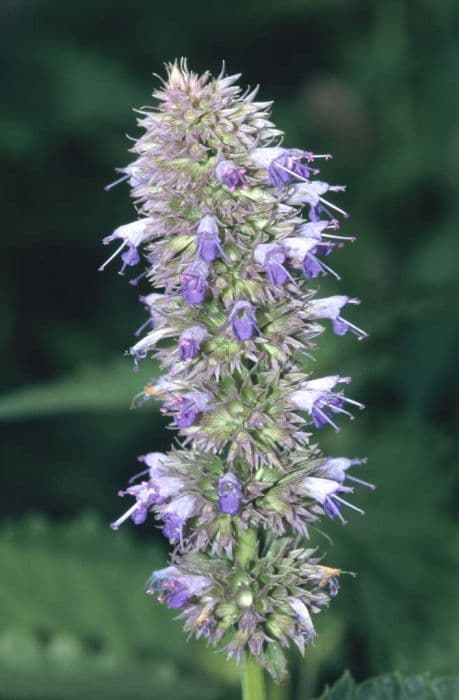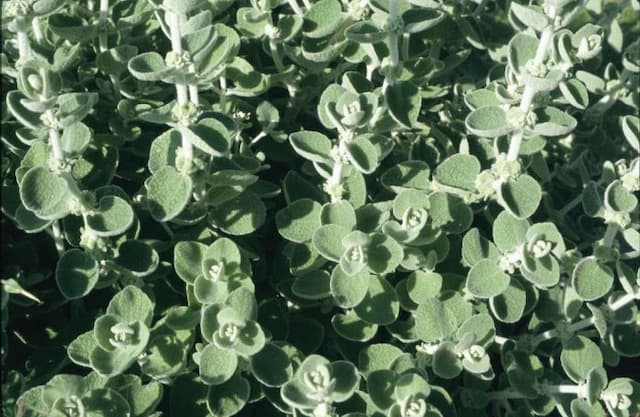Rosemary Salvia rosmarinus 'Roman Beauty' (PBR) (Ro)

ABOUT
The 'Roman Beauty' rosemary is a perennial herb distinguished by its compact and mounded growth habit. It showcases slender, needle-like leaves which are rich in aromatic oils, providing a distinctive scent often associated with cooking. The color of the foliage ranges from deep green to grayish-green, depending on the light exposure and other environmental factors. During its blooming season, 'Roman Beauty' produces small, two-lipped flowers that are usually a shade of light blue or lavender, adding a subtle splash of color to the plant's otherwise monochromatic green palette. These flowers are attractive to pollinators, such as bees and butterflies. Overall, the 'Roman Beauty' rosemary presents as a bushy, robust herb with a tangled appearance due to its interwoven stems and dense growth of leaves.
About this plant
 Names
NamesFamily
Lamiaceae
Synonyms
Roman Beauty Rosemary, Prostratus Rosemary, Creeping Rosemary
Common names
Rosmarinus officinalis, Rosmarinus officinalis var. prostratus, Rosmarinus officinalis 'Prostratus', Rosmarinus prostratus.
 Toxicity
ToxicityTo humans
Rosemary, including the variety Salvia rosmarinus 'Roman Beauty', is generally considered non-toxic to humans and is widely used as a culinary herb. If consumed in extremely large quantities, it could potentially cause some side effects due to its volatile oils and other compounds. These side effects might include gastrointestinal irritation or allergic reactions in some very rare cases. However, under normal circumstances, when used in cooking or as a seasoning, rosemary is safe and not associated with toxicity.
To pets
Rosemary, known scientifically as Salvia rosmarinus and specifically the 'Roman Beauty' variety, is considered non-toxic to pets, including dogs and cats. It is commonly used in foods and can occasionally be found as an ingredient in pet foods or treats. Therefore, consuming rosemary in typical household quantities is generally seen as safe for pets and does not result in poisoning. If a pet were to ingest an unusually large amount, it might experience mild digestive upset, but this is not common.
 Characteristics
CharacteristicsLife cycle
Perennials
Foliage type
Evergreen
Color of leaves
Green
Flower color
Blue
Height
2 feet (60 cm)
Spread
2 feet (60 cm)
Plant type
Shrub
Hardiness zones
8
Native area
Mediterranean
Benefits
 General Benefits
General Benefits- Culinary Uses: Widely used as a seasoning in a variety of dishes, from meats and poultry to soups and breads.
- Aromatic Foliage: Releases a pleasant, pine-like fragrance when touched, which can enhance the sensory experience of a garden.
- Landscape Ornamentation: Offers aesthetic benefits with its attractive needle-like leaves and blue to purplish flowers.
- Drought Tolerance: Once established, it is quite drought-resistant, making it suitable for xeriscaping and arid environments.
- Herb Garden Staple: An essential component of a classic herb garden, complementing other herbs both visually and in culinary use.
- Wildlife Attraction: Flowers can attract beneficial insects like bees, promoting pollination in the garden.
- Easy to Propagate: Can be easily propagated from cuttings, allowing gardeners to expand their collection without additional cost.
- Compact Growth: 'Roman Beauty' has a compact and trailing growth habit, which makes it suitable for containers and small spaces.
 Medical Properties
Medical Properties- Improves digestion: Rosemary has traditionally been used to help alleviate digestive problems.
- Antioxidant effects: Contains compounds that can neutralize free radicals, potentially reducing oxidative stress.
- Anti-inflammatory properties: May help to reduce inflammation in the body.
- Enhances memory and concentration: Sometimes used in aromatherapy to boost cognitive functions.
- Antimicrobial activity: Can inhibit the growth of certain bacteria and fungi.
- Analgesic effects: May provide pain relief for headaches and muscle pains.
- Respiratory health: Inhaled rosemary oil is sometimes used for respiratory issues.
- Stress relief: The scent of rosemary is believed to have a calming effect, which could help to lower stress levels.
 Air-purifying Qualities
Air-purifying QualitiesThis plant is not specifically known for air purifying qualities.
 Other Uses
Other Uses- As a natural dye: The leaves of Rosemary can be used to create a natural dye for fabrics, typically resulting in shades of green and yellow depending on the mordant used.
- In potpourris and sachets: Dried rosemary leaves are often included in potpourris and sachets for their aroma and natural moth-repellent properties.
- As a flavoring for homemade soaps and candles: Rosemary essential oil is commonly used to scent homemade soaps and candles.
- In companion planting: Rosemary can be planted alongside vegetables like broccoli and cauliflower to help repel insect pests.
- As a natural wood preservative: Rosemary oil can be used to treat wood surfaces as it has natural antiseptic properties, which may help to prolong the life of the wood.
- To create flavored oils and vinegars: Fresh rosemary sprigs are steeped in oils or vinegars to infuse them with flavor for culinary use.
- As incense: Dried rosemary sprigs can be burned as a fragrant incense to freshen the air in a house.
- In pet care products: Rosemary extract is often found in natural pet shampoos and conditioners, helping to repel fleas and improve skin health.
- As a hair rinse: A rinse made from rosemary leaves can add shine and potentially darken hair over time.
- For homemade cleaning products: Rosemary’s antiseptic properties make it a good ingredient for natural homemade cleaning solutions.
Interesting Facts
 Feng Shui
Feng ShuiRosemary is associated with purification and protection in Feng Shui. It is believed to have the ability to cleanse the air of negative energies and protect the home from bad influences. Place rosemary near the entrances to your home or in the kitchen to promote a clear, healthy environment and to attract positive energy.
 Zodiac Sign Compitability
Zodiac Sign CompitabilityRosemary is not used in astrology practice.
 Plant Symbolism
Plant Symbolism- Memory - Rosemary, including the cultivar 'Roman Beauty', is often associated with remembrance and memory, a tradition that dates back to ancient times.
- Fidelity - Rosemary is sometimes used in wedding ceremonies to symbolize the loyalty and faithfulness between partners.
- Friendship - Presented as a gift, rosemary can symbolize the bonds of friendship and the desire to remember good times shared.
- Healing - Historically, rosemary has been connected to healing processes due to its medicinal properties.
- Protection - In folklore, rosemary is thought to ward off evil spirits and negative energies, offering protection to those who keep it nearby.
- Love - Some traditions hold rosemary as a symbol of love, possibly because of its aromatic qualities that could be linked to the essence of love's allure.
 Water
WaterRosemary 'Roman Beauty' should be watered deeply but infrequently, aiming to mimic its natural Mediterranean environment. Ensure the soil is allowed to dry out between waterings to prevent root rot. During the growing season, watering once every 1 to 2 weeks with about 1 gallon per plant, depending on the climate and soil drainage, should suffice. In the winter, reduce watering to once a month, or less if it rains.
 Light
LightRosemary 'Roman Beauty' thrives in full sun, requiring at least 6 to 8 hours of direct sunlight daily. Choose a spot in your garden that receives ample sunlight throughout the day to ensure healthy growth and optimal oil production in the leaves.
 Temperature
TemperatureRosemary 'Roman Beauty' prefers warmer climates with temperatures ranging between 55°F and 80°F for ideal growth; however, it can tolerate temperatures as low as 20°F for short durations. Protect the plant from frost and ensure that it is not exposed to temperatures below 30°F for prolonged periods.
 Pruning
PruningPruning Rosemary 'Roman Beauty' helps maintain its shape and encourages new growth, enhancing its culinary use. Trim the plant lightly in early spring or after blooming to keep it bushy and compact. Avoid heavy pruning; instead, regular snipping for kitchen use suffices. The best time for a more thorough pruning is in the spring or after flowering.
 Cleaning
CleaningAs needed
 Soil
SoilRosemary 'Roman Beauty' thrives in well-draining, sandy or loamy soil with a pH between 6.0 and 7.5. A mix of two parts potting soil to one part coarse sand or perlite is ideal. Ensure adequate drainage to prevent root rot.
 Repotting
RepottingRosemary 'Roman Beauty' should be repotted every 1-2 years or when it becomes root-bound. Choose a pot just slightly larger than the existing one to allow for growth.
 Humidity & Misting
Humidity & MistingRosemary 'Roman Beauty' prefers a dry environment with low to moderate humidity levels. Avoid high humidity to prevent fungal diseases.
 Suitable locations
Suitable locationsIndoor
Place rosemary 'Roman Beauty' in bright, indirect light.
Outdoor
Plant in full sun with good air circulation.
Hardiness zone
7-11 USDA
 Life cycle
Life cycle'Roman Beauty' rosemary (Salvia rosmarinus 'Roman Beauty') starts its life cycle when seeds are sown or when stem cuttings are taken and rooted, leading to the growth of a new plant. The seedling stage follows, where the plant develops its first true leaves and begins to establish a root system. As it enters the vegetative stage, the plant grows steadily, producing more leaves and branches, and reaching maturity. During the flowering stage, typically in spring and summer, 'Roman Beauty' produces its aromatic, blue to lilac flowers, which attract pollinators. After pollination, if conditions are favorable, the flowers may develop into small fruits containing seeds, completing the reproductive cycle. The plant then enters a period of dormancy in colder months, reducing growth, until conditions become suitable for the next growth cycle.
 Propogation
PropogationPropogation time
Spring-Early Summer
Rosemary, specifically the Salvia rosmarinus 'Roman Beauty' (PBR) (Ro), can be propagated effectively through the method of stem cuttings. This popular method often takes place in late spring or early summer when the plant's growth is most vigorous. To propagate, a gardener would select a healthy, non-flowering stem and cut a piece approximately 2 to 4 inches (5 to 10 centimeters) long, making the cut just below a leaf node. The lower leaves are then stripped, and the cut end may be dipped in rooting hormone to encourage root development. The cutting is placed in a pot with well-draining soil, kept moist but not soggy, and covered with a plastic bag or placed in a propagator to maintain high humidity. It typically takes a few weeks for the cutting to root, after which it can be transplanted into its own pot or into the garden.









